Clothes ~ how to declutter and organize clothes
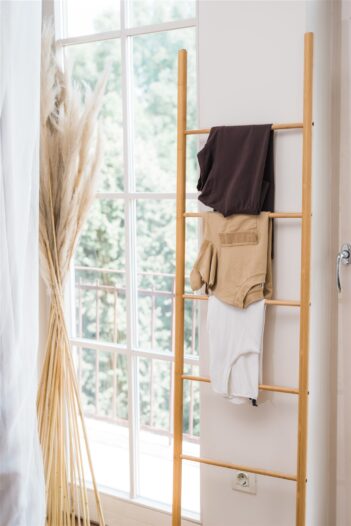
The first category in the KonMari method is clothing, which contains unique KonMari folding techniques and numerous questions concerning storing and organizing. Read the table of contents below to find the section you need if you’re looking for something specific.
1. Steps how to declutter and organize your clothes
- Step ~ Prepare your place and boxes for decluttering
- Step ~ Make a pile of your clothes
- Step ~ Joy checking ~ check to see if every item brings you joy
- Step ~ Folding the clothes KonMari way
- Step ~ How to store and organize your clothes the KonMari way
2. Is it better to hang or to fold clothing?
3. Doesn’t KonMari folding take a really long time?
4. Does the KonMari method produce wrinkles to your clothes?
5. Is it always preferable to fold our clothes?
6. How to hang clothes Konmari way?
7. Correct way to fold and store socks
8. How to fold and store ties
9. Children clothes
10. Sleepwear and loungewear
11. How to pack a suitcase
1. Steps how to declutter and organize your clothes
Step 1. Prepare your place and boxes for decluttering

Choose a place where you can gather all of your clothing in one place. A bed in the bedroom, table in the dining room or kitchen both function wonderfully. Sort clothing into four categories: sell, craft/repair, donate, and discarding.
Step 2. Make a pile of your clothes
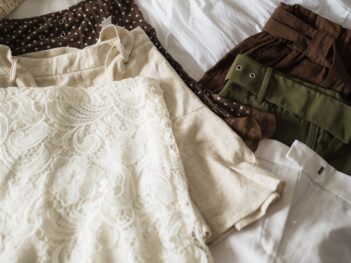
Examine every location where you keep clothing, including closets, baskets, the washer and dryer, a pile for ironing, and even clothing that has been stored for a different season. Try to group your items into subcategories while you are piling them up, such as socks on one side, t-shirts on another, dresses on the third side, etc. If you see that there are too many clothes, divide subcategories by room, and place your dresses in living room, your underwear in the bathroom etc.
Step 3. Joy checking ~ check to see if every item brings you joy
To be more objective, start with offseason clothes so that you can be more objective. It will be more difficult to decide whether to keep something you recently wore.
Additionally, it is simpler to start with shirts and blouses before moving on to pants and skirts, socks, and undergarments.
Pick your top three favorites clothe items that will act as a benchmark. Keep them close by while you are joy checking other items. They represent the final 10, and I wouldn’t go below a 5 or a 6.
Take each item in your hands and notice how it makes you feel. Does the item spark joy? Did your heart skip a beat, did you grin, or did remorse and despair overtake you instead?
If the piece of clothes has a deeper meaning for you, (because of the person you got it from or memories you had while wearing it), then treat this piece as sentimental one, leaving it for the last category.
Here are some questions to guide you through this joy check process if you find it challenging to makea choice:
~ When was the last time you wore the item?
~ Do you like the colour and texture?
~ How do you feel when you wear it?
~ Are you excited about wearing this in the future?
~ When is the next time you think you’ll be able to wear it?
~ Do you feel like your better self when you wear it?
~ Would you invest the time, money, and effort to fix it if it were damaged (by a stain, a tear, etc.)?
~ Would you wear this for a date today (casual clothes for sports day date and formal clothes for dinner date)?
~ When you bought this item, what were you really hoping to own? E.g. in case you subsequently gain or lose weight?
~ Did you feel that as a woman you need to have dress, shorts, skirt, blazer etc but you are really not a dress (skirt, blazer) person?
~ Did you make a purchase to make yourself feel better while you were down?
Create a separate pile labeled “not sure, need to try it on,”, and after joy checking have your own fashion show in front of the mirror!
If you are still not sure, then keep the item with confidence and place it to the front of your wardrobe. Try to wear it as much as you can outside over the course of the following two weeks to see how it makes you feel. In order for one of the two things to occur, be sure to place it in front of your wardrobe with your preferred pieces. Either it will blend in flawlessly and become one of your top picks, or it will bother you so badly that you won’t hesitate to donate it this time.
If the item doesn’t spark joy, but it was expensive so you feel obliged to have it, put it on and ask yourself, “Do I want to wear this out somewhere?” without thinking about the cost. Think about it objectively. Donate or sell without hesitation if there is no delight. You will make someone really happy and you will learn a lot what you love and don`t love to wear.
Put the items you know you love but you are embarrassed to wear it (perhaps some 80s hit), in the “decoration box”. At the end of the tidying festival, you can go over the box and figure out how to use those items in new ways, for example, on the walls or other surfaces.
Thank the items you have let go – this is the final and important aspect of joy checking. At one point the item brought us joy and had a purpose that is now satisfied. They also help us learn whether or not we like similar items and what about those items bothers us (texture, shape, color etc). If you forget to thank each item while discarding, give the entire box a big hug and say “thank you.”
Step 4. Folding the clothes KonMari way
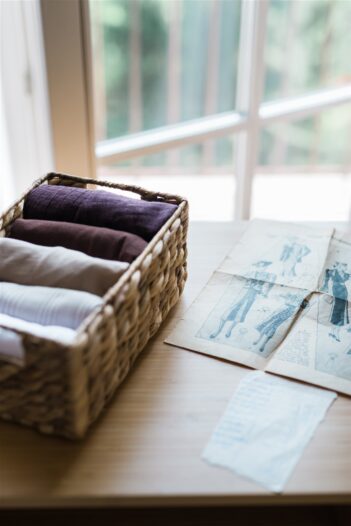
The goal is to make a small rectangle that can stand upright on its own. When put in the drawer we need to see every item like books.
- Lay the item out flat
- Smooth it with your hands and send love through your palms
- Imagine the rectangle in the center of the item and fold each side toward the center,
- Fold the top of the item toward the bottom leaving a little gap at the edge
- Fold the item in thirds or quarters
- Stand the item upright
These are the basic steps for folding KonMari-style. Please feel free to browse the specific item here or on my YouTube channel as I have videos showing how to fold each sort of clothing organized by next categories: baby clothes, man`s clothes, women clothes, hanging clothes that needs to be folded for travel, linen items, special items and how to pack a suitcase.
Step 5. How to store and organize your clothes the KonMari way
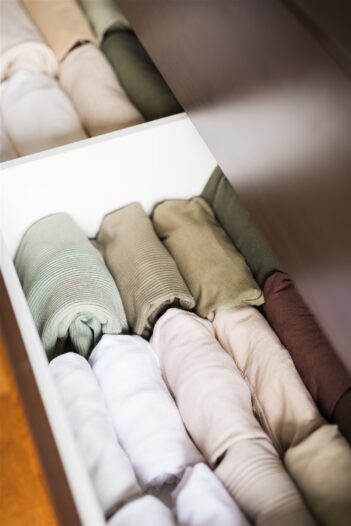
- Store in drawers if you have
- Store in beautiful boxes if you have shelves instead of drawers – if there is a high gap between the shelfs, place a second shelf in between to create more space, otherwise put box on top of the box
- Store with light colors in the front and darker colors at the back for cleaner appearance and better visibility
2. Is it better to hang or to fold clothing?
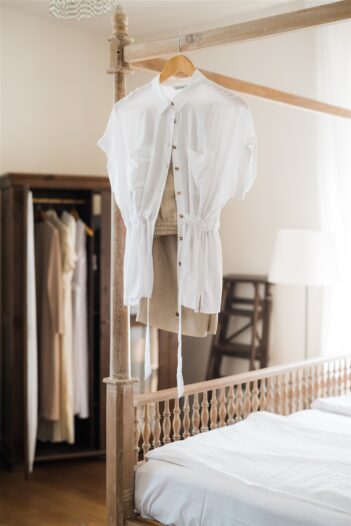
The folding of clothes is the most well-known aspect of the KonMari process, and for a good reason. When compared to hanging, folding your garments like cassettes can create up to four times more storage space. Folding is done out of love and respect for the clothing we wear, not just to make more room in the closet. We use our palms to glance over the material when we fold it, and this action has the same effect on our clothing as it does when we touch or grasp someone’s hand. At the same time, we will also straighten the fabric and see if there are any spots or wholes. We treat it with the same respect we would any other item we cherish and care for, while also appreciating how it not only provides us with essential protection but also boosts our self-esteem.
Additionally, folding the clothes is an excellent meditation technique. Every time our thoughts wander, we strive to draw our attention back to a physical feeling (in this example, touch, which is usually breath). The next time you don`t feel like doing the laundry, remind yourself that you`ll also meditate for 5 to 10 min, which can have a big impact on your life.
3. Doesn’t KonMari folding take a really long time?
One thing to keep in mind is that folding can take some time the first time we do it, especially when we take out all of our clothing that we own to joy check. However, with practice and with only one load of machine, we will be much faster in the future, the same we were before, because Konmari folding has only one more fold than usual folding.
4. Doesn’the KonMari method produce wrinkles to your clothes?
No, if done correctly. Each time you fold a section of the item, press firmly with your palm over the entire fabric. Actually, the Konmari method of folding only involves one extra fold over the standard method, which also prevents wrinkles in the clothing. Furthermore, rather from being a result of folding, creases are really brought on by the weight of other garments piled on top of one another.
5. Is it always preferable to fold our clothes?
No, because of their material, some clothing items won’t stand up after folding. After folding, you have two options: leave them flat or find out whether they like to be hung. There are other items, such as coats, jackets, blouses with particularly delicate materials, etc., that are better hung than folded. Tights and socks, on the other hand, can be rolled rather than folded.
Given that we must fold when we travel, I have created a special video playlist that shows you how to fold hanging garments. You can find it here.
6. How to hang clothes Konmari way?
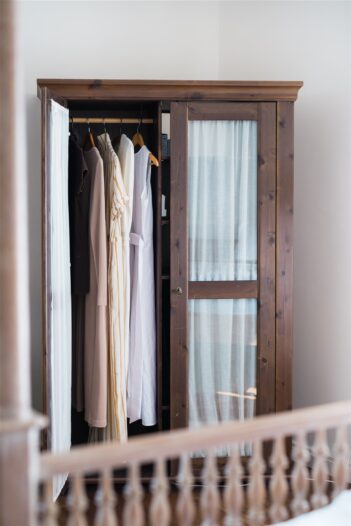
When we hang our clothes in the closet, we follow these two rules:
1. Hang all items of the same type (all dresses) together and in the following order: coats, dresses (they are long), jackets, pants, skirts, blouses.
2. The color and material should go from darker, longer and heavier on the left to lighter, shorter and more fluid on the right. That way the closet appears more finished since it appears as though they rise to the right.
Rules may occasionally cross one other, making it difficult to follow, as in the case of the short black light dress. It should be on the far right because it is light and short yet it should be on the far left because it is black. Follow your intuition as to how you want it to appear in your closet and consider whether using it one way or the other will be more convenient for you. When you are deciding what to wear, do you decide by looking at the color or the material?
7. Correct way to fold and store socks
How to organize socks while still having enough place for them is one of the most commonly asked questions. The ball is the most typical technique to fold a pair of socks. It is best to do opposite and just fold them once or twice. When folded in the ball, elastic gets stretched just like when we are wearing them and they don`t have time to rest. Not to mention that your drawer will have a lot more space. Put them in compact, open boxes so they can stand up and take up the least amount of room.
You can see how to fold men socks here, and women socks and leggings here.
The second most occurring thing with socks is that we tolerate holes. Treating our feet with the quality socks is important because they support us all day. That also applies to slippers and shoes.
8. How to fold and store ties
1. Put the thinner end on top of the wider end up to the label, to get a rectangle. Fold up the narrow part towards the wider part up to the label, leaving a gap at the edge. Fold six/seven times or just roll up. Store them in drawers or beautiful boxes from dark to light so they are clearly visible at first glance.
2. Hang them with necktie hanger or a regular one or put necktie pole on the inside of the closet door.
Here is a video showing how to fold a tie.
9. Sleepwear and loungewear
One of the wonderful things that KonMari has taught me is how do I feel at home matters. Avoid dressing in anything that would make you feel embarrassed to be seen if the doorbell rang unexpectedly. Once you start caring about how you appear and feel when no one is looking, you’ll start to develop a better sense of yourself.
10. Children clothes
Children who are older than three can begin to decide what sparks joy to them, and this is a wonderful opportunity for them to express themselves. If they don’t want to discard, teaching them how to fold can encourage them to give away because the space is more tidy. You can find here how to fold baby clothes.
11. How to pack a suitcase
- Fold the clothes so they can stay upright
- Fold suits and lay them flat on top
- Pack bras on top and don’t flatten them
- Pack subcategories of clothes in different travel pouches (underwear, socks, t-shirts etc.)
- Transfer lotions and toiletries into smaller bottles to reduce volume
- When unpacking, set a timer for 30 min – storing everything back or in wash machine and wipe the outside of suitcase as well as wheels.
If you want to see how to pack your suitcase, look here, or if you want to see how to organize clothes that normally hang on hangers, look here.
